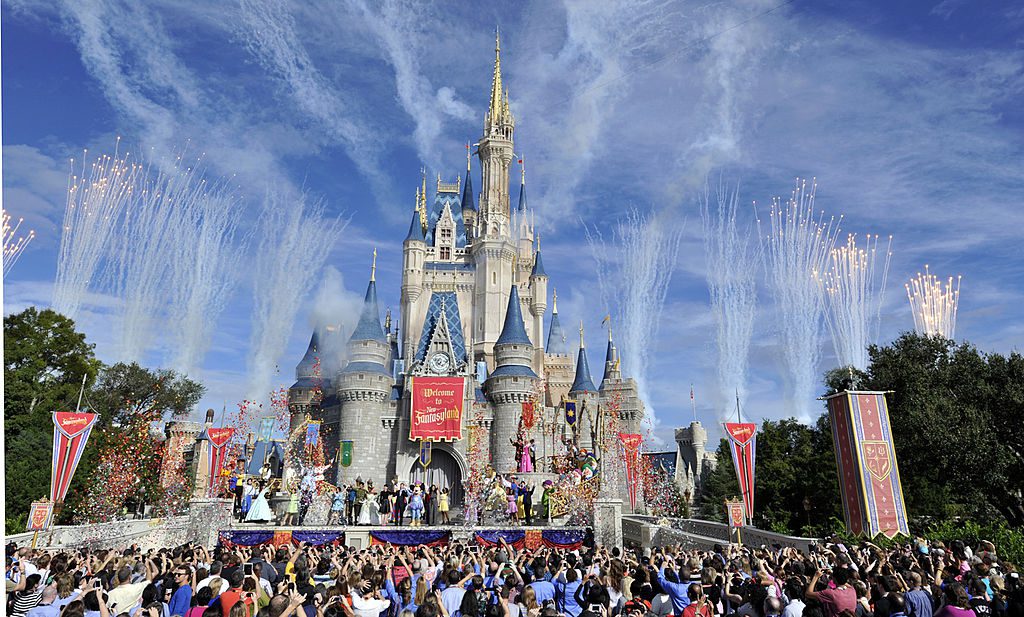When You Virtue-Signal Upon a Star…

My family is from New England, which meant none of us could ever relax unless we were in the state of Florida. So it was that every so often as a child, my parents would fly us down to Disney World for a summer vacation. Even back then, the place was a tourist trap—my uncle used to compare it to a vacuum cleaner sucking money out of your back pocket—and we cut costs where we could, shouldering around water bottles and coolers of sandwiches. Yet I also made many fond memories at those parks: braving the Tower of Terror for the first time, watching the SpectroMagic parade twinkle past.
Disney World was what it was, a campy hunk of plastic Americana proofed of all irony that after too long could start to feel creepy and compulsory (“you’re having fun at the happiest place on earth, right???“). But it was also something else: distinctly middle-class, the preferred vacation getaway for the family with three kids. Today, those same middle-class families are being priced out of the fun. During the 2010s, Disney World ticket prices soared at twice the rate of inflation. When the Magic Kingdom, the resort’s most popular park, opened in 1971, a one-day adult ticket cost $3.50; by 2004, it was $54.75; today it’s $109.
How did Mickey become such an avaricious lout? There are many answers to that question, some of them more justifiable than others. One is that Disney World has added three parks and countless new attractions since it opened, meaning there’s more to do and thus more to charge for. Plus, as anyone who’s ever tried to squeeze through Adventureland on a summer afternoon knows, the parks fill up rapidly, necessitating crowd control. But another answer is that Disney has its eye on the same financial trend lines as everyone else. They know that economic inequality is increasing, that there’s good money to be had among the top 10 percent, that catering to wealthy travelers and influencers can be very lucrative.
So it is that a Florida amusement park with something called a “Country Bear Jamboree” has increasingly become a playground for the global rich. (Think Jeff Bezos and Klaus Schwab putting their hands up before the Splash Mountain drop. Is there nothing left for the rest of us?)
I bring all this up because Disney would also like you to know that it stands with the marginalized peoples of the world. The company has lately gone full woke, releasing its first black and Pacific Islander princess movies. Its recent live-action Beauty and the Beast film co-starred a gay LeFou and its animated movie Onward featured its first openly lesbian character. Last summer, it struck a partnership deal with woke martyr Colin Kaepernick.
Disney’s Lucasfilm division recently made a point of firing Mandalorian actress Gina Carano because she had made comments that were deemed anti-Semitic or anti-Ewok or something. And thankfully the company remains ever vigilant as to the racist threat posed by the Muppets, adding a content advisory to The Muppet Show on its Disney Plus streaming service that warns of supposedly stereotypical depictions. (How do I get in on this racket? Grumbling reactionaries like me have been culturally appropriated by Statler and Waldorf for far too long.)
This woke blitz has even infiltrated the theme parks, long known for being allergic to controversy. Last summer, after the killing of George Floyd, Disney announced it was overhauling its Splash Mountain flume ride to make it more racially sensitive. It wasn’t entirely clear why. Splash Mountain is based on the animated movie Song of the South, which can certainly be accused of racism and has been attacked as such ever since its 1946 release. But it wasn’t as though Br’er Fox was popping up next to your log and screaming the N-word. The ride itself was harmless fun. It lifted the Song of the South characters out of their initial context and refashioned them into something more inoffensive, which seems like exactly what needed to happen.
Not so, apparently. My point here isn’t to bemoan every one of Disney’s ventures into wokeness: bring on the Kurdish princess, say I, as well as the Guyanan one and the Ulster unionist one. The more cultural representation of this wonderfully various world of ours, the better. What galls me is the superficiality of it all. The Disney way seems to be to ostentatiously extol the downtrodden while simultaneously screwing them with confiscatory prices and meager salaries. It’s all well and good to have a girl power-themed fairy tale; less so if the castle grounds have the lowest wages of any metropolitan area in the country. Yet here comes former CEO Bob Iger to assure everyone that Disney is committed to making its executive board more racially diverse. Well, thank God for that.
What makes this all the more surreal is that Disney has long been known as a conservative company, moving cautiously so as to avoid alienating its everyman customer base. To the extent it ever had an ideology, it was the beaming can-do capitalism of founder Walt. As it shifts now to wokeness, as it abandons that same middle class, perhaps it’s time we acknowledged that these two trends are ineluctably intertwined.
Comments